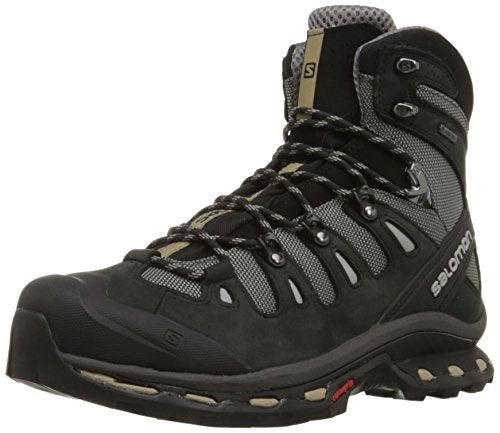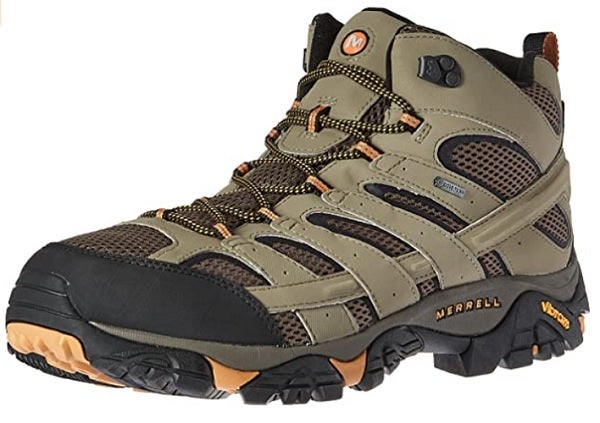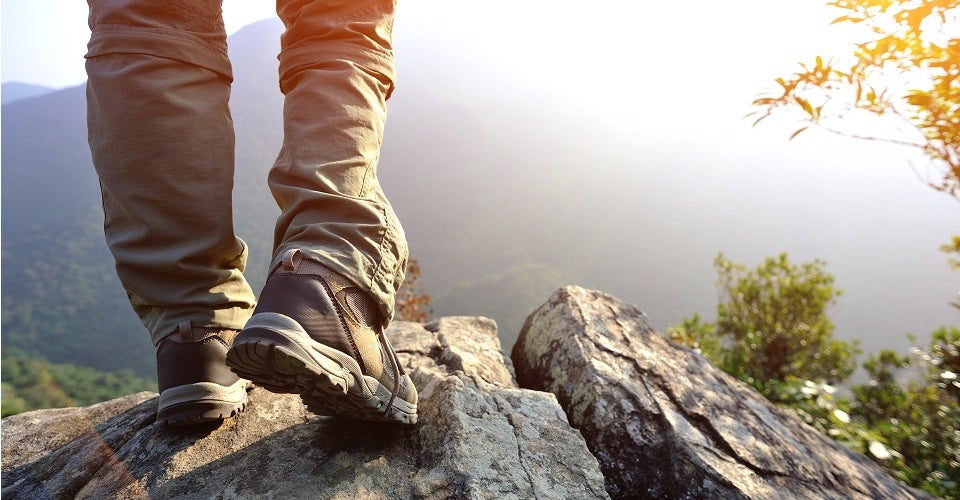
Our Editors independently research, test, and rate what we feel are the best products. We use affiliate links and may receive a small commission on purchases.
I remember back in college when a buddy asked me if I had some hiking boots because he wanted me to go with him on an adventure. I thought I had some nice ones, so I agreed to go. It was a fun outing at first, but it turned bad in a hurry when I found out that my footwear was not up to the task at hand. My feet still hurt just thinking about the blisters I wound up with, and on top of that, I rolled my ankle. I learned from that adventure and now wear the best hiking boots I can get that fit my feet. I can’t stress this enough – wear good footwear when you plan an adventure. The best hiking boots mix comfort and support, and have features like being lightweight and waterproof that you will need for a fun day traveling off the beaten path.
And we didn’t forget. We have separate article on Women’s hiking boots here.
Best Hiking Boots For Men
For more of our hiking gear recommendations, have a look through these popular Outside Pursuits guide links: Hiking Pants, Hiking Rain Jackets, Trekking Poles
Quick Answer: The 7 Best Rated Men’s Hiking Boots For 2021
- Salomon Quest Prime GTX Boots
- Vasque Breeze Mid GTX Boots
- Merrell Moab 2 Mid Gtx Hiking Boot
- Asolo TPS 520 GV Men’s Hiking Boot
- Columbia Men’s Newton Ridge Plus
- Timberland White Ledge Men’s Waterproof Boot
- KEEN Targhee II Mid WP
Our reviews of the top rated hiking boots with our guide and comparison table will help you choose the right pair for you.
Men’s Hiking Boot Reviews
#1 Salomon Quest 4D 2 GTX Hiking Boot – Editor’s Pick
- GORE-TEX waterproof protection
- Thick rubber toe cap
- Lightweight synthetic leather and textile upper
- Gusseted Tongue
Salomon makes some great alpine equipment and is well known across multiple sports for making some of the highest quality technical gear on the market. This high-top backpacking boot is a gnarly contender and features some great aspects for those seeking a beefy hiking boot.
Rubber contra grip outsoles, again, are some of the absolute best shoe components on the market today and they maintain excellent traction when wet. This is awesome for climbing wet or slick rocks and river crossings. Salomon has paired the boot with a nice Gore-Tex liner for waterproof breathable functionality.
The boot itself is designed around the “4D” chassis system to reinforce and protect the foot and provide ankle support so you can expect a heavy, stiff boot. The front of the boot features a fully wrapped toe box with a rubber toe cap for maximum overall protection. Definitely a serious boot meant to take on extreme conditions. If you have wide feet, checkout the Salomon X Ultra 3 Wide Mid GTX boots. The Saloman Quest Prime GTX boots are possibly the best boots for hiking available.
#2 Vasque Breeze Mid GTX Waterproof Hiking Boots – Comfort Pick
- GORE-TEX waterproof protection
- Lightweight leather and textile upper
- Dual Density EVA footbed for all day comfort
- Rubber toecap
Leather and fabric combine to make the overall upper of this boot both breathable, flexible, and durable. Vasque also works directly with Vibram to integrate an exclusive sole tread compound called “XSTrek” for this boot. Rubber toe cap, reflective piping on the boot, and a dual density foot bed make for a bulky, yet functional full size pair of trekking boots.
These waterproof hiking boots are affordable and yet still features most every major specification of any great hiking boot. In the past I’ve seen Vasque boots not tend to hold up as well as some major brands but I also know tons of hikers who swear by the brand. This boot features Gore-Tex liners for waterproof and breathable function on the trail so it’s pretty hard to argue against the value. The Vasque Breeze are some most comfortable hiking boots you can buy, highly recommended.
#3 Merrell Moab Mid Waterproof Hiking Boot – Lightweight Pick
- Breathable Gore-Tex waterproofing with ghillie lacing
- Lightweight synthetic leather and textile upper
- Ortholite anatomical footbed
- Rubber toecap
Merrell is popular name in hiking footwear and for good reason. With features like Gore-Tex that sets the standard when it comes to waterproof hiking boots. Using a blend of synthetic leather for waterproofness and a textile mesh blend for breathability that gives these boots the best of both worlds. There’s not much to go wrong here. The Merrell Moab’s feature high lacing boot with moderate sole lugs with Vibram soles for a solid footing and grip in mud and slippery conditions. I would have expected a bit larger toe cap for protection but based on the overall size of this boot, it shouldn’t be necessary.
I really like the “Bellows” tongue on these boots, it does an excellent job keeping rocks and debris out of the boot. The Moab’s feature a “ghillie” lacing, this style gives you a very a secure lacing system and have standard D lacing at the top. The boots have also been treated to keep bacteria growth down and them odor free. With a very reasonable price that will appeal to a wide range of day hikers, they are probably the best lightweight hiking boots.
#4 Asolo TPS 520 GV Hiking Boot – Premium Pick
- PU coated leather, suede, mesh upper
- Shank under the arch for stability
- Omni-Grip non-marking rubber sole
- Rubber toecap
My first pair of hiking boots (and last) were a pair of Asolo Fugitives. While those boots didn’t make the list, the Asolo TPS 520 GV has a spot for one of the most well-loved boots on the trail. Many hikers swear by full length, full leather, rugged boots for backpacking. While I don’t subscribe to this, it’s no contest that these boots have a lot going for them. The full grain leather surrounds and protects a layer of Gore-Tex waterproof membrane and once broken in, the boots will do their job for years.
Two major drawbacks come to mind. First, the leather boot will last far longer than the waterproof membrane. Eventually you’ll be left with a nice leather boot which is not at all waterproof. Second, you’re going to have to trade lightweight shoes for a heavy, clunky, full-size boot with something like the TPS 520 GV. Overall there are lots of positives about this boot that make it a good choice. In my opinion the Asolo TPS are some of the best Men’s hiking boots available at any price.
#5 Columbia Granite Ridge Mid Waterproof Boot – Best Under $100
- PU coated leather, suede, mesh upper
- Shank under the arch for stability
- Omni-Grip non-marking rubber sole
- Rubber toecap
It can really be hard to find a classic looking hiking boot these days. While Columbia decided to use leather and synthetics in combination for this boot, overall it looks like a traditional hiker. One thing I like is the riveted metal lacing and two speed laces on the upper cuff. This boot is going to wear and feel more like a traditional leather work boot. With waterproof membranes, they’re expecting this boot to hold up to large puddles and muddy conditions.
Overall this would be a good consideration for those looking to find the ankle support and protection of a high-top boot with the price tag of an affordable trail runner. I love the aggressive lugs on the boot’s tread but I wish they would have extended the toe cap a bit for better protection from rocks and logs. Overall, I think Columbia Granite Ridge’s are the best hiking boots under $100.
#6 Timberland White Ledge Waterproof Hiking Boots – Budget Pick
- Rugged waterproof leather upper
- Removable dual-density EVA footbed
- Multidirectional traction lugs
- Rubber toecap
This is a boot I’ve seen on the trail firsthand, many times. It’s popular for the classic leather construction and look. With Timberland waterproofing, oiled leather and fully protected toe box. It’s meant to be waterproof but this will break down over time. I like the double speed laces on the top of the cuff. This allows some adjustability for ankle movement based on how your foot is feeling.
While I like the boot overall and think it’s a good option for those on a budget, I wish they would have put a nicer sole on it. The lugs are large but they don’t extend to the sides at all. This makes it easy for the boot to quickly get full of mud and unable to regain traction. I think the boot would gain some value with more aggressive side lugs. In the end, however, it’s a fine budget option for those looking for Men’s waterproof hiking boots.
#7 KEEN Targhee II Mid WP Hiking Boot – Waterproof Budget Pick
- Lightweight waterproof leather/mesh upper
- Removable dual-density EVA footbed
- Ghillie lacing for comfort and secure fit
- Aggressive lugged outsole for secure traction
Keen came up with a seriously beef looking boot. With a synthetic and leather construction, there’s a combination of the breathability of textiles with the rugged durability of nubuck leather. Of course, it’s over the ankle which makes it a heavy option for backpackers but the top speed lace can be locked down or left undone for some adjustability in support.
I love the huge over the toe cap on this boot since the lower and the tread is so beefy, why not make the toe cap rugged enough to match? It’s also awesome to see a heel lock strap which is integrated with the top lace. When you tighten up the top lace, it also pulls and locks the heel down into the bottom of the boot. This is a great feature we don’t see nearly enough in hiking shoes. Rear and tongue pull loops are just a nice finishing touch for a boot that’s rugged, large, and built to lock your foot into a serious piece of hiking gear. The Targhee’s may be the best waterproof hiking boots for a reasonable price.
Men’s Hiking Boot Comparison Table
| Hiking Boot | Upper | Sole | Weight (pair) | Features | |
|---|---|---|---|---|---|
| Salomon Quest GTX Hiking Boot | Synthetic and textile | Rubber sole | 39 oz | GORE-TEX waterproofing and protective rubber toe cap. | |
| Vasque Breeze Waterproof Hiking Boots | Leather and textile | Synthetic sole | 39 oz | GORE-TEX waterproofing with breathable nylon mesh panels | |
| Merrell Moab Mid Waterproof Hiking Boot | Synthetic leather and mesh | Vibram sole | 31 oz | Gore-Tex for waterproofing w/ Vibram sole and aggressive lugs | |
| Asolo TPS 520 GV Boot | Full-grain leather | Vibram sole | 38 oz | Waterproof breathable Gore-Tex insert with Vibram sole for traction | |
| Columbia Newton Ridge Plus Boot | Full-grain leather and mesh synthetic | Rubber sole | 38 oz | Omni grip rubber outsole for traction that are designed to shed mud | |
| Timberland White Ledge Waterproof Boot | Full-grain leather | Rubber sole | 36 oz | Removable EVA footbed & multidirectional traction lugs |
|
| KEEN Targhee II Mid WP Hiking Boot | Leather and textile | Rubber sole | 35 oz | Breathable leather lining and aggressive lugs for traction |
How to Choose the Best Men’s Hiking Boots – Buying Guide
- Ankle Support and Boot Height
- Hiking Boot Categories
- Snake Bites
- Waterproof
- Types of Hiking Footwear
- Hiking Boot Midsoles
- Weight
- Best Hiking Boot Brands
- Comparison of Hiking Boots
- FAQs About Hiking Boots
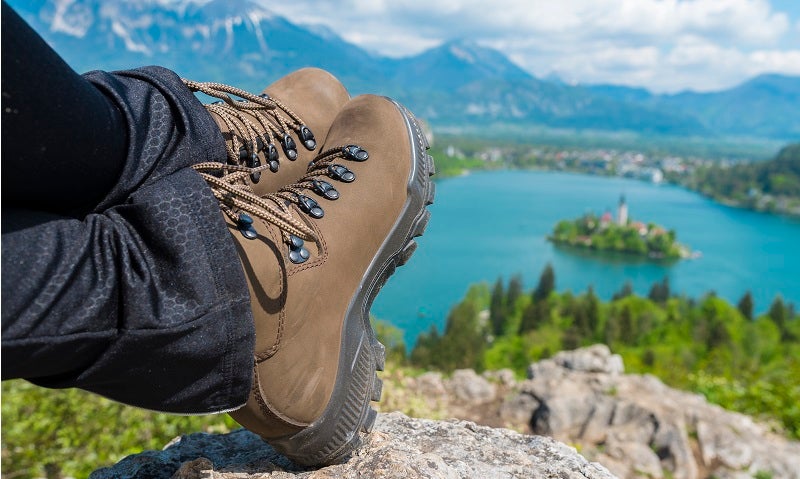
You’ll still run across a crowd who will swear by knee-high full leather hiking boots. There are also those who won’t be caught dead in hiking boots and instead opt for hiking shoes in most conditions. Whichever camp you may fall into, we’ll talk about some of the pros and cons of hiking boots, how to choose the right pair and suggest a few top performers.
Ankle Support and Boot Height
Many will swear by the ankle supporting qualities of high cuff walking boots. These boots, which come up above the ankle, can be laced tightly to snugly help surround the ankle with boot material. This, in my experience, is more likely to just help you avoid scraping your ankles on a stick or rock than to actually help support the ankle.
Of course, if you have chronic ankle problems, I would suggest you simply go with whatever your doctor recommends or work with a physical therapist to find a good solution. For me, however, I rarely roll my ankle anymore and even in the worst situations it doesn’t injure or hinder me greatly so this is a non-factor in my choice of footwear.
Hiking Boot Categories
Lightweight
Lightweight hiking boots going to be the most flexible and versatile for hiking boots. They are usually tough enough for a week long hike and of course shorter day hikes. These types of hiking boots are made from more synthetic and mesh materials than leather to save on weight. As a result they tend to be cheaper, lighter and less durable than their leather constructed cousins. With a more flexible design, they will not provide the same amount of support, depending on where you are hiking and the terrain this may not be an issue.
Midweight
In the middle and a compromise between lightweight and heavyweight hiking boots are the midweights. This boot offers more support with a stronger, more durable sole and upper. Also more nubuck leather and waterproofing is available with the heavier weight. This type of boot is ideal for longer hikes over terrain that is not too difficult and rocky. While not reviewed above, the LOWA Boots Renegade GTX Mid boots are a good choice.
Heavyweight
Here we have full on support and protection for your feet with a cost of weight. In this categories were going to find full grain leather boots with full waterproofing. The Salomon X Ultra GTX Mid are a good choice for heavyweight boots. Stiffness and less flexibility are a notable downside but you gain more support for hiking with a heavier load like with a full pack or a baby carrier. If you plan on hiking over rocky, rough terrain, this type of boot is almost a necessity. Something to keep in mind with this type of boot is the break in period. Do not just head out on the trail for a weeklong hike without a prior break in period.
Snake Bites
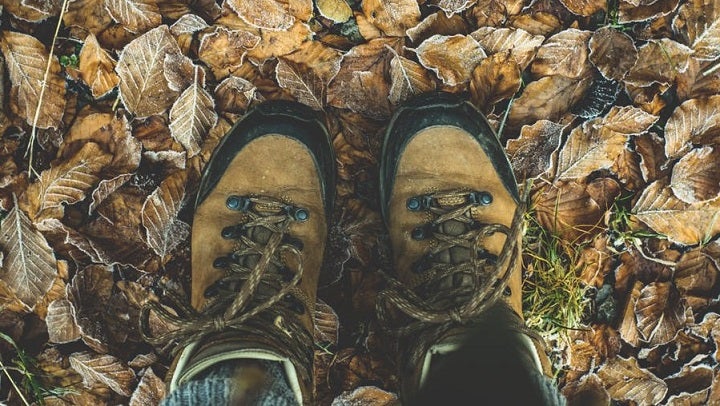
I’ve heard this more than once so, if it seems ridiculous to you, let’s just talk about it for a moment. Some will tout high boots as snake resistant or possibly helping to turn the tooth and bite of a wayward snake. Unfortunately, the likelihood of a snake biting at the level of the boot cuff or below is relatively low especially when you compound that with the overall low likelihood of being attacked by a snake at all.
For me, I will take millions of steps over the course of my walking and hiking excursions. Of those millions of steps, perhaps one (someday) will encounter a snake. I’ll take my chances and instead of wearing “snake armor” I’ll just educate myself about snake behavior, habitat, hiker attacks, and medical responses and the reality of the dangers of snake venom. Altogether, not a viable reason for me to recommend hiking boots.
Waterproof Hiking Boots
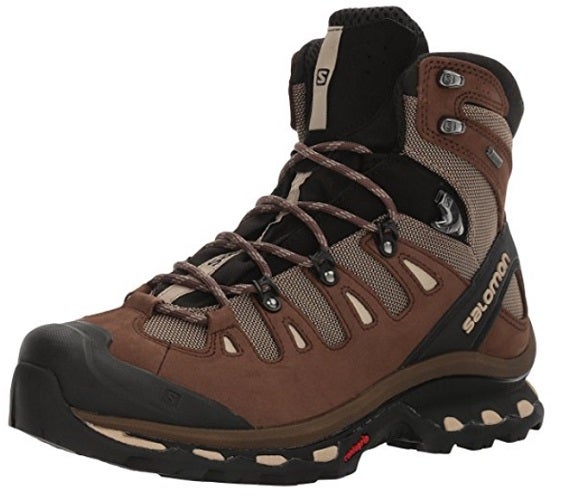
Many new hikers are obsessed with waterproof gear. Waterproof backpacks, bags, sleeping bags, tents, shoes, boots, and everything else under the sun. Waterproof footwear has several huge and glaring drawbacks and we’ll talk about a few of them here:
- Water can still come in from the top of the boot where your foot goes in. If you step in water deeper than the boots cuff (river crossing or deep puddles) or if rain leaks down your legs or rain pants (almost guaranteed) then your waterproof boot is now a swimming pool for your foot.
- Even breathable waterproof footwear will retain moisture and standing water for hours or even days.
- Waterproof membranes simply suck once water manages to get inside the boot – they just hold in the water and make your foot marinade in nasty foot water as your skin becomes dangerously macerated.
- Waterproof membranes are fragile and breakdown quickly under abrasion and movement. In a shoe or boot critical wear points are subjected to constant flexion and abrasion from your foot, rocks, dirt, pebbles, and other grit both inside and outside the shoe.
- Almost without exception the waterproof membrane will break down before the boot does and now you’re left with a functionless waterproof piece of footwear.
The only time I use or value waterproof backpacking boots is in colder season conditions where trails may be muddy, snowy, or icy. In these conditions getting your feet wet can be dangerous or harmful and staying dry and warm as long as possible is always prudent. In these conditions, it is necessary to consider some method by which to keep your feet safely warm and dry – either waterproof socks, vapor barriers, trash bag liners, or waterproof footwear.
Toe Protection (Toe Cap)
A cap on the front of the boot will provide protection for your toes when you inevitably kick a rock or boulder. This thick piece of rubber will save your toes when you do this. The Salomon Quests are a perfect example of a boot providing a toe cap with maximum protection. If you don’t plan on hiking rocky terrain you can probably forgo this feature as it does add some weight to the boots.
Lacing
Perhaps one of the most overlooked parts of a hiking boots is the lacing setup of the boot. Cheaper boots tend to have a poor lacing setup that are not only harder to adjust to get a proper fit but also do not stay adjusted and tend to loosen up as you hike. The primary factor in the lacing setup of the boot naturally are the laces. A poor quality lace can be easily replaced with better ones. So if you notice them constantly loosing up, invest in some better laces.
Pro Tip: Look for hiking boots where a hook is at the top of the boot like the Asolo Hiking Mid GTX Boots.

Types of Hiking Footwear
There are several major classes of hiking footwear and, since we’re talking about hiking boots, it’s necessary to identify and define the other categories. In the hiking world, there are trail runners, hiking boots, and mountaineering boots.
Trail Runners
Are more athletic shoes similar to tennis shoes with a low-cut ankle, lightweight design, and athletic fit. For day hikers a lighter shoe may be better suited for you, see our hiking shoes.
Hiking Boots
Are usually above the ankle cut boots with thick and heavy Vibram outsoles with beefy construction. Meant for longer backpacking trips with heavier pack loads. I like Salomon Men’s Quest 4D 2 GTX and the Lowa Renegade GTX Mid for a good all around hiking boot.
Mountaineering Boots
These boots are made specifically for extreme expeditions and offer extreme insulation, protection, and integration into external systems such as crampons. The Asolo Men’s TPS 520 GV Boot is a good option for Mountaineering boots.
Stability
The primary purpose of a hiking boot is to provide stability and protection for your feet. To provide that stability, a shank is used. This is a stiff piece of plastic between the insole and outsole (around the arch of your foot) of the boot that gives the boot its strength and stiffness. The more difficult and technical the terrain the more support and stiffness you need in your boot. A stiffer boot will result in less calf fatigue vs a hiking shoe. A more stable boot is usually comes at the cost of more weight.
For shorter hikes that are on trails I would highly recommend staying with a lighter more flexible boot like the Merrell Moab Mid Hiking Boot. As you progress to longer and more technical terrain with a heavier load, a more stable boot like the Asolo TPS 520 GV Hiking Boot is a good choice.
Hiking Boot Upper Materials
Let’s cover the most common materials that make up hiking boot uppers.
Nubuck Leather
Similar to suede leather, nubuck is a full grain leather that is water proof, durable and flexable but requires a “break in” periods so don’t rush out on a 20 mile hike in your brand new boots.
Full Grain Leather
Probably the most common material for hiking boots, full grain leather is extreamly durable and resists abrasion. With it’s durability it is used in boots designed for longer backpacking trips and where superior water resistance is needed. Full grain leather boots also require a break in period.
Split Grain Leather
Split grain leather is just like it sounds, the leather is split in half and the rougher part of the leather removed. Used in lightweight hiking boots and often paired with a synthetic material to provide water resistance.
Synthetic
There are a variety of materials making up the synthetics. Most common being nylon and synthetic leather. The advantage of synthetic is less expense and more flexibility and shorter break in period.
Membranes
Many hiking boots and shoes feature a GoreTex or eVent membrane to provide water resistance. However the membrane also decreases “breathability” of the boot and in warm weather can make your feet sweat.
Types of Hiking Boot Midsoles
Probably the main reason to wear a hiking boot is for foot and ankle support for carrying larger loads. To help with shock and impact reduction, hiking boots incorporate a midsole into the boots. The midsole is placed in between the boot liner and the sole of the boot and varies in thickness depending on role of the boot.
Thin midsoles are normally found in hiking or trail running shoes whereas a thick EVA foam midsole is found in beefy hiking boots.
PU
PU or polyurethane is found in hiking boots meant for more demanding conditions for hikers carrying heavy loads. It’s more durable than EVA foam but less “cushy” and doesn’t compress over time. Choose this if your more into mountaineering or carry a heavy pack load over longer distances.
EVA
EVA foam is found in most hiking boots of the mid or lightweight type. EVA foam provides excellent shock and impact protection and more comfortable.
Keep in mind not all EVA is equal and varies from very soft found typically in womens boots to a stiffer midsole in more heavyweight boots. If your more a day hiker a soft cushy EVA foam is fine but for more rigorous hiking look for a stiffer midsole for the extra support.
Weight
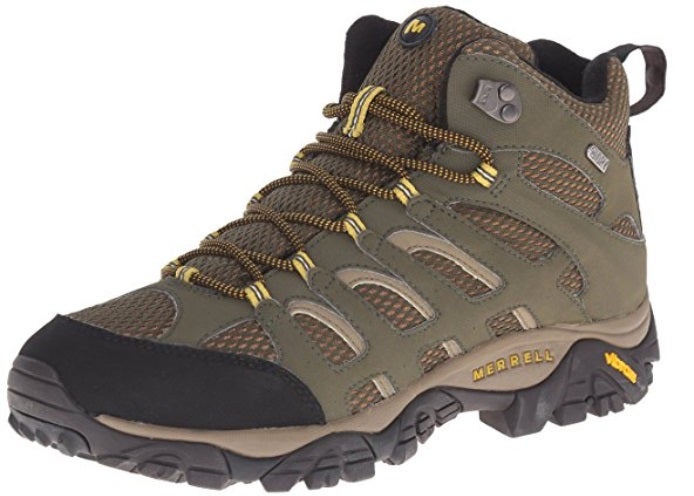
The saying goes that “one pound on your feet equals five pounds on your back” and it couldn’t be more true. According to many studies, empirical evidence, and a large body of writing, “Weight on the feet is disproportionately more exhausting than weight carried on the torso.”
Why is this so? Because once under motion your torso, backpack, and body remain under motion during normal hiking conditions. Your feet, however, do not. When walking, your feet must constant accelerate and stop with every step and, if you remember from physics class, it takes a lot more energy to get something started moving than to keep it moving. Every time you pick up and put your feet down, any extra weight on them is going to make it harder and harder to do so – expending more energy.
Don’t believe me? Log a 25-mile hiking day with beefy over-the-ankle hiking boots on your feet and then compare it to a 25-mile day with a well-fitting pair of lightweight trail running shoes. You’ll feel the difference. No matter what type of footwear you decide is appropriate for you, lighter is always better!
FAQs About Hiking & Backpacking Boots
Q: What is a boot toe cap?
A: A toe cap is a protector in the fron of the boot that is ually made of rubber or plastic that is there to prevent bruised toes from kicking rocks or roots as you walk.
If you have ever kicked a rock in a shoe or boot without one you know how painful it can be. Not only is it lead to a bruised or swollen toe it can ruin your hike. I have seen many a hiker have to evacuated for jammed and bruised toes.
All these problems can be avoided with a simple toe cap, make sure the boots you buy have one!
Q: Are waterproof boots worth the extra cost?
A: There is no simple answer and it really all comes down to where you plan on hiking. The big weakness with waterproof boots is that no matter how waterproof the boot is, water can come in over the top of the boot.
Once you get water in the boot, the same reason the boot is waterproof will be the same reason they won’t dry out easily. If this happens when its cold out, this can become a potenially dangerous situation leading to frostbite.
For the shoulder seeasons like mid October to December or mid March to late April you can benefor from a hiking boot with a WPB membrane. Otherwise a lightweight hiking boot is probably a better choice.
Q: What is a boot lug?
A: You have probably heard this term and it’s quite simple. Boot lugs are the large treads on the sole of the boot and around the edges.
Lugs are usually large and obvious and protude around the boot like the tread around a set of truck mud tires. They are perfect for hiking in muddy conditions and dig into the soft dirt give your traction so you don’t slip.
If you plan on hiking in wet or muddy conditions, look for large lugs on your hiking boots. Large lugs will be better at shedding mud while you walk. Small lugs will tend to get packed with mud and offer no traction.
Q: What are boot gatiers and should I use them?
A: You have probably seen them but not realized with they were. A gaiter wraps around the top of the boot and reaches up your leg and cinches.
Hikers wear gaiters to keep rain, mud, rocks and sticks from getting into your boots. If it rains hard they will help for a bit but eventually water will get in. For trail hiking a short lightweight gaiter will do but for backcountry or winter hiking will be better off with a taller gaiter that reaches up to your knees.
Q: Should I wear custom insole in my boots?
A: While there is no downside to using a custom fitted insole in your boot you are probably wasting your money if you have never had any foot problems.
On the other hand if you have had other shoes or boots with custom fitted insoles because of foot issues like fallen arches or high arches you may bee to customize your footbed.
Some hikers use expensive aftermarket footbeds that can be installed by them. You should talk to an ortopedic dotor and get their opinion of what adjustments you should make.
Ill fitted footbeds are not only a waste of money they can lead to injury. Don’t just guess and change out the insoles on the recommendation of a friend. Get the opinion of a doctor who can examine your feet and give you a professional opinion.
Outside Pursuits Overview
Ultimately, it’s up to you to choose what type of footwear makes the most sense for your own uses. Whether you choose a lightweight trail runner or a rugged and beefy boot like the Asolo TPS 520 GV, you’ll soon learn the inherent shortcomings of each type of footwear. I started with hiking boots and still use them on a few very rare occasions (still have that old pair of Asolo Fugitives kicking around).
Before taking backpacking trips with a pair of hiking boots, it’s critical to break in the boot. Every full-size hiking boot has a break in period during which the stiff boot begins to loosen up and conform to your foot. Starting on the trail with a brand-new pair of boots is never a good idea and I’ve seen it result in blisters and evacuations from the trail. After buying your new hiking boots, be sure to spend at least a few weeks wearing them during normal activity to break them in before hitting the trail.

